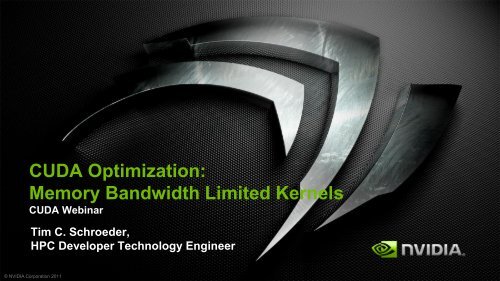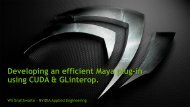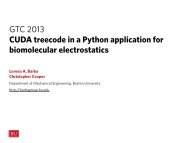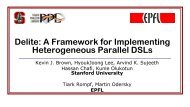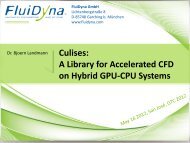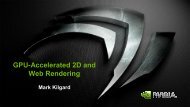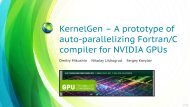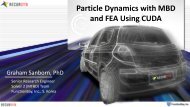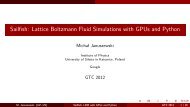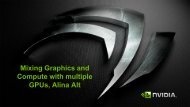Memory Bandwidth Limited Kernels - GPU Technology Conference
Memory Bandwidth Limited Kernels - GPU Technology Conference
Memory Bandwidth Limited Kernels - GPU Technology Conference
You also want an ePaper? Increase the reach of your titles
YUMPU automatically turns print PDFs into web optimized ePapers that Google loves.
CUDA Optimization:<strong>Memory</strong> <strong>Bandwidth</strong> <strong>Limited</strong> <strong>Kernels</strong>CUDA WebinarTim C. Schroeder,HPC Developer <strong>Technology</strong> Engineer© NVIDIA Corporation 2011
Outline• We’ll be focussing on optimizing global memory throughput onFermi-class <strong>GPU</strong>s• Launch Configuration• <strong>Memory</strong> Access Patterns• Using On-Chip <strong>Memory</strong>• Summary, Further Reading and Questions© NVIDIA Corporation 2011
© NVIDIA Corporation 2011Launch Configuration
Launch Configuration• Conclusion: Have enough loads in flight to saturate the bus,or handle multiple elements per thread with independentloads, same performance. Typically, you’d like 512+ threadsper SM• Independent loads and stores from the same thread• Loads and stores from different threads• Larger word sizes can also help (float2 is twice the transactions of float,for example)• For more details:• Vasily Volkov’s GTC2010 talk “Better Performance at Lower Occupancy”© NVIDIA Corporation 2011
© NVIDIA Corporation 2011<strong>Memory</strong> Access Patterns
GMEM Operations• Two types of loads:• Caching- Default mode- Attempts to hit in L1, then L2, then GMEM- Load granularity is 128-byte line- Program configurable: 16KB shared / 48 KB L1 OR 48KB shared / 16KB L1• Non-caching- Compile with –Xptxas –dlcm=cg option to nvcc- Attempts to hit in L2, then GMEM- Load granularity is 32-bytes© NVIDIA Corporation 2011
Load Operation• <strong>Memory</strong> operations are issued per warp (32 threads)• Just like all other instructions• Operation:• Threads in a warp provide memory addresses• Determine which lines/segments are needed• Request the needed lines/segments© NVIDIA Corporation 2011
Caching Load• Warp requests 32 aligned, consecutive 4-byte words• Addresses fall within 1 cache-line• Warp needs 128 bytes• 128 bytes move across the bus on a miss• Bus utilization: 100%addresses from a warp...032 64 96 128 160 192 224 256 288 320 352 384 416 448<strong>Memory</strong> addresses© NVIDIA Corporation 2011
Non-caching Load• Warp requests 32 aligned, consecutive 4-byte words• Addresses fall within 4 segments• Warp needs 128 bytes• 128 bytes move across the bus on a miss• Bus utilization: 100%addresses from a warp...032 64 96 128 160 192 224 256 288 320 352 384 416 448<strong>Memory</strong> addresses© NVIDIA Corporation 2011
Caching Load• Warp requests 32 aligned, permuted 4-byte words• Addresses fall within 1 cache-line• Warp needs 128 bytes• 128 bytes move across the bus on a miss• Bus utilization: 100%addresses from a warp...032 64 96 128 160 192 224 256 288 320 352 384 416 448<strong>Memory</strong> addresses© NVIDIA Corporation 2011
Non-caching Load• Warp requests 32 aligned, permuted 4-byte words• Addresses fall within 4 segments• Warp needs 128 bytes• 128 bytes move across the bus on a miss• Bus utilization: 100%addresses from a warp...032 64 96 128 160 192 224 256 288 320 352 384 416 448<strong>Memory</strong> addresses© NVIDIA Corporation 2011
Caching Load• Warp requests 32 misaligned, consecutive 4-byte words• Addresses fall within 2 cache-lines• Warp needs 128 bytes• 256 bytes move across the bus on misses• Bus utilization: 50%addresses from a warp...0 32 64 96 128 160 192 224 256 288 320 352 384 416 448<strong>Memory</strong> addresses© NVIDIA Corporation 2011
Non-caching Load• Warp requests 32 misaligned, consecutive 4-byte words• Addresses fall within at most 5 segments• Warp needs 128 bytes• 160 bytes move across the bus on misses• Bus utilization: at least 80%- Some misaligned patterns will fall within 4 segments, so 100% utilizationaddresses from a warp...0 32 64 96 128 160 192 224 256 288 320 352 384 416 448<strong>Memory</strong> addresses© NVIDIA Corporation 2011
Caching Load• All threads in a warp request the same 4-byte word• Addresses fall within a single cache-line• Warp needs 4 bytes• 128 bytes move across the bus on a miss• Bus utilization: 3.125%addresses from a warp...032 64 96 128 160 192 224 256 288 320 352 384 416 448<strong>Memory</strong> addresses© NVIDIA Corporation 2011
Non-caching Load• All threads in a warp request the same 4-byte word• Addresses fall within a single segment• Warp needs 4 bytes• 32 bytes move across the bus on a miss• Bus utilization: 12.5%addresses from a warp...032 64 96 128 160 192 224 256 288 320 352 384 416 448<strong>Memory</strong> addresses© NVIDIA Corporation 2011
Caching Load• Warp requests 32 scattered 4-byte words• Addresses fall within N cache-lines• Warp needs 128 bytes• N*128 bytes move across the bus on a miss• Bus utilization: 128 / (N*128)addresses from a warp...032 64 96 128 160 192 224 256 288 320 352 384 416 448<strong>Memory</strong> addresses© NVIDIA Corporation 2011
Non-caching Load• Warp requests 32 scattered 4-byte words• Addresses fall within N segments• Warp needs 128 bytes• N*32 bytes move across the bus on a miss• Bus utilization: 128 / (N*32)addresses from a warp...032 64 96 128 160 192 224 256 288 320 352 384 416 448<strong>Memory</strong> addresses© NVIDIA Corporation 2011
Impact of Address Alignment• Warps should access aligned regions for maximum memory throughput• L1 can help for misaligned loads if several warps are accessing a contiguous region• ECC further significantly reduces misaligned store throughputExperiment:– Copy 16MB of floats– 256 threads/blockGreatest throughputdrop:– CA loads: 15%– CG loads: 32%© NVIDIA Corporation 2011
REFERENCESr ,1.2.3.4.5.6.7.8.9.10.11.12.13.14.15.JOHNSON, H.H. and WILNER, A.M. “Moisture and Stable Crack Growth in a High-StrengthSteel”. Applied Materials Research, January 1965, p 34.MQSTOVOY, S. and RIPLING, E.J. “The Feasibility of Using Fracture Mechanics forEvaluating High-Hardness Armow Steel”. US Army Tank Automotive Command, Warren,Michigan, Technical Report No. 10580, 19 June 1969.PIPER, D.E., SMITH, S.H. and CARTER, R.V. “Corrosion Fatigue and Stress CorrosionCracking in Aqueous Environments”. Metals Engineering Quarterly, v. 8, August 1968,p 50.NOVAK, S.R. and ROLFE, S.T. “Modified WOL Specimen for KISCC EnvironmentalTesting”. J. OfMaterials, v. 4, no. 3, 1969, p 701.BROWN, B.F. “A New Stress-Corrosion Cracking Test for High-Strength Alloys”.Materials Research and Standards, v. 6, no. 3, 1966, p 129.SRAWLEY, J.E. and GROSS, B. “Stress Intensity Factors for Crack-Line-Loaded Edge-Crack Specimens”. Materials Research and Standards, v. ?, no. 4, 196 7, p 155.MOSTOVOY, S., CROSLEY, P.B. and RIPLING, E.J. “Use of Crack-Line-Loaded Specimensfor Measuring Plane-Strain Fracture Toughness.” J. of Materials, v. 2, no. 3, 1967,p 661.HYATT, M.V. “Use of Precracked Specimens in SCC of High-Strength Aluminum Alloys”.Boeing Document 06-24466, November 1969.HEYER, R.H. and McCABE, D.E. “Plane-Stress Fracture Toughness Testing Using a Crack-Line-Loaded Specimen”. Engineering Fracture Mechanics, v. 4, 19 72, p 393.HEYER, R.H. and McCABE, D.E. “Crack Growth Resistance in Plane-Stress FractureTesting.” Engineering Fracture Mechanics, v. 4, 1972, p 413.BROWN, W.F., Jr. “Effects of Some Dimensional Variables for Compact Tension Specimens”.Note for ASTM E-24 Sub I, September 23,1969.“Tentative Method of Test for Plane-Strain Fracture Toughness of Metallic Material”.ASTM Specification E399- 70T, March 19 70.HICKEY, C.F., Jr. “Toughness Data from Monolithic High Hardness Armow Steel”.AMMRC, Watertown, Mass., PTR 72-3, July 1972.BENJAMINy W.D. and STEIGERWALS, E.A. “An Incubation Time for the Initiation ofStress-Corrosion Cracking in Pre-Cracked 4340 Steel”. Trans. ASM, v. 60, no. 4,.1967, p 547.WEI, R.P., NOVAK, S.R. and WILLIAMS, D.P. “Some Important Considerations in theDevelopment of Stress Corrision Cracking Test Methods”. Materials Research and Standards,v. 12, no. 9, 1972, p 25.
Shared <strong>Memory</strong>• Uses:• Use it to improve global memory access patterns• Cache data to reduce redundant global memory accesses• Inter-thread communication within a block• Performance:• Program configurable: 16KB shared / 48 KB L1 OR 48KB shared / 16KB L1• Very low latency• Very high throughput: 1+ TB/s aggregate© NVIDIA Corporation 2011
Additional “memories”• Texture and Constant• Read-only• Data resides in global memory• Read through different caches• Additional fast on-chip memory• Avoid polluting L1© NVIDIA Corporation 2011
© NVIDIA Corporation 2011Summary
Summary• Strive for perfect coalescing• Align starting address (may require padding)• A warp should access within a contiguous region• Have enough concurrent accesses to saturate the bus• Process several elements per thread- Multiple loads get pipelined- Indexing calculations can often be reused• Launch enough threads to maximize throughput- Latency is hidden by switching threads (warps)• Try L1 and caching configurations to see which one works best• Caching vs non-caching loads (compiler option)• 16KB vs 48KB L1 (CUDA call)- Sometimes using shared memory or the texture / constant cache is the bestchoice© NVIDIA Corporation 2011
Further reading• GTC 2010 Talks:• Fundamental Performance Optimizations for <strong>GPU</strong>sPaulius Micikevicius• Analysis-Driven OptimizationPaulius Micikevicius• Better Performance at Lower OccupancyVasily Volkovhttp://www.gputechconf.com/page/gtc-on-demand.html© NVIDIA Corporation 2011
Questions?


